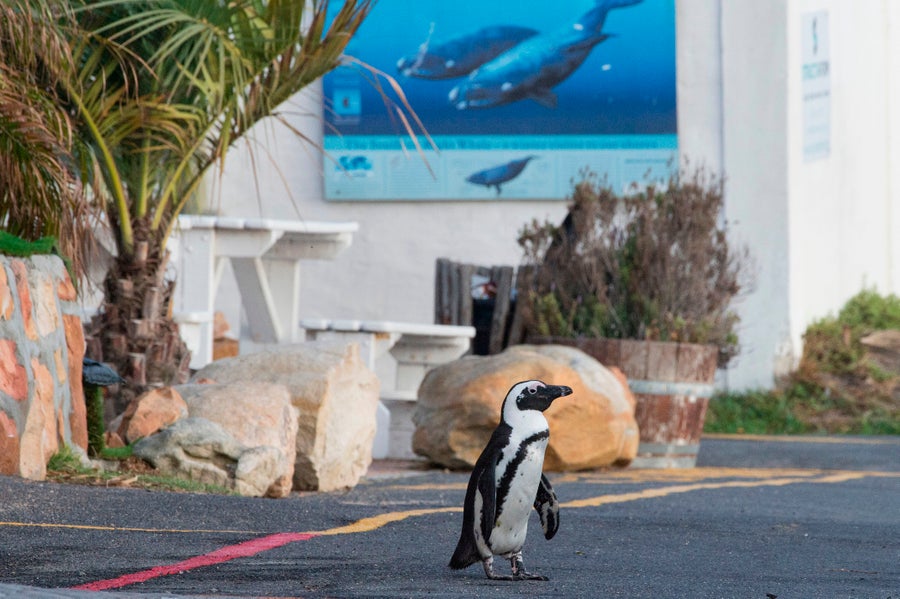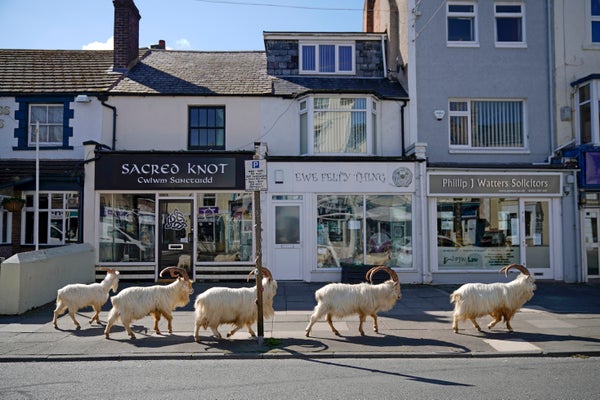A family of lions takes a midday nap in the middle of a road in South Africa’s Kruger National Park. On a nearby golf course, a lioness sips water from a pond while spotted hyenas and African wild dogs play wrestle on the grass. Halfway around the world, a herd of wild goats feasts on a Welsh town’s manicured lawns and hedges. And in California, black bears wander through empty campgrounds. With so many humans cooped up at home during the coronavirus pandemic, these animals and others have been adjusting to a world relatively free of people—and the fear they engender.
Animals that are afraid of predators rely on a sort of mental map of their habitats. They use this map to stick near safer areas and avoid riskier ones, a phenomenon scientists call the “landscape of fear.” All predators influence their prey, but we humans are unique in our extensive ability to shape that landscape because we are such prolific killers—and because we slay animals at all levels of the food web. Human hunters can use extremely efficient lethal technologies. We can collaborate with dogs to pursue prey. And we routinely kill animals without even trying to, such as by hitting them with our cars. So it makes sense that our disappearance from roads, golf courses and other spaces we usually dominate is letting animals relax to a very noticeable extent. “This is certainly all consistent with the landscape of fear,” says Liana Zanette, a biologist at Western University in Ontario who studies the topic. How animals react while humans are holed up—and then again as we emerge—is something of an unintentional experiment that could offer new details about the pervasive ways a wariness of humans shapes the natural world.
The bodies of fearful animals flood with stress hormones, which fuel quick responses. If such creatures see, smell or hear a predator nearby, they might drop whatever they are doing to run away and hide, gear up for a fight or freeze so their movements do not give them away. Even if there is no sign of an immediate threat, anxious animals may search for food less in order to have more time to monitor their surroundings for potential danger.
On supporting science journalism
If you're enjoying this article, consider supporting our award-winning journalism by subscribing. By purchasing a subscription you are helping to ensure the future of impactful stories about the discoveries and ideas shaping our world today.
Whereas some fears are innate—such as humans’ fear of spiders or snakes or a ground squirrel’s fear of foxes—others are learned, either through direct experience or observing others. Most animals have good reason to be terrified of people: a 2015 analysis reported that recreational and commercial hunters fell their “prey” at rates up to 14 times higher than those of nonhuman predators. Human prey even include apex predators such as cougars, which hunters kill around nine times more frequently than nonhuman predators do. Some biologists have begun to call our species “superpredators.”

An African penguin walks in the parking lot of an empty restaurant, close to popular Boulders Beach in Cape Town, South Africa, on April 14, 2020. The beach closed during the lockdown across South Africa, due to the COVID-19 pandemic. Credit: Rodger Bosch Getty Images
Research conducted by Zanette and others shows how the special dread of humans changes the behaviors of many types of animals. In a 2016 experiment, Zanette found that European badgers were more fearful of people than they were of dogs and bears. Though badgers initially hid in their burrows when loudspeakers broadcast the sounds of bears or dogs, their need for food eventually spurred them to leave safety. But when they heard the sounds of people, the badgers never emerged—they would not even poke their head out.
Large, intimidating carnivores fear us as well. A 2017 investigation by Zanette found human conversations played over loudspeakers rattled cougars in northern California so much that they abandoned their kills before getting enough to eat. “They ate about half as much just because they thought people were around,” she says. Numerous studies have shown that even when animals seem tolerant of people, they invariably wind up altering their day-to-day lives to cope with stresses we create: a 2018 paper, for example, revealed that sea lions and fur seals spent less time resting on the beach when gawking tourists got too close or too loud.
Now that the world has become at least a little bit less terrifying for wildlife, it is reasonable to expect that at least some animals would react in noticeable ways. “I’m not surprised at all,” says Kaitlyn Gaynor, an ecologist at the University of California, Santa Barbara. “We have seen studies that animals move less [and] become more nocturnal around people and adjust their behavior to avoid us. So it is definitely possible that these patterns are reversing” with humans stuck at home during the current pandemic.
Some exceptions may be animals dwelling in urban and suburban areas, Gaynor says. With more people entering local parks and natural areas to get out of the house—in the absence of options such as restaurants and sports venues—these animals may be even more stressed than they were before.
When COVID-19 lets up, and people once again venture from their homes more regularly, Gaynor expects things to return to some version of normal, with animals once again going well out of their way to avoid us. But the transition probably will not be like flipping a light switch. “It won’t necessarily happen immediately—and not necessarily uniformly,” she says. For example, creatures that once steered clear of roadways might take time to resume their avoidance, and in the meantime, speeding cars may hit more of them than usual. When wild animals lose their fear of people is generally when they get into trouble. Until they regain it, humans may have to to accept some inconveniences to avoid harming them in unexpected places. That response may mean driving more slowly or keeping pets on short leashes. “We might need to renegotiate our relationship with wildlife,” Gaynor says.
She and Zanette also note that the current situation has had interesting repercussions for field research into such animal behaviors. On one hand, scientists can follow the movements of some creatures using GPS collars and motion-activated cameras to see what they do when humans are out of sight—and then as we return. “It has turned into an accidental experiment,” Gaynor says.
But on the other hand, some work has been put on pause. Ironically, Zanette had earlier planned to travel to Kruger National Park and surrounding areas this summer to see if mammals such as impalas and kuduwere more wary of human noise when they were in areas that allowed hunting, compared with the park—where they cannot be hunted but may have to contend with the constant presence of tourists. The Skukuza Golf Club,where large carnivores were recently filmed enjoying the sunshine, was to be one of her field sites. “It’s incredibly frustrating,” she says. “This is the perfect time to go and study these superpredator questions we’ve been interested in.”
Despite those frustrations and the temporary nature of the current respite for wild animals, Gaynor sees the anecdotes of creatures out and about as reasons to remain sanguine about wildlife conservation. “It is a testament to the fact that animals are often incredibly resilient and flexible,” she says. “It gives me hope that they can bounce back from human disturbance.”
Read more about the coronavirus outbreak from Scientific American here. And read coverage from our international network of magazines here.
